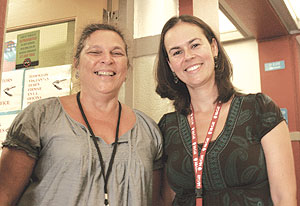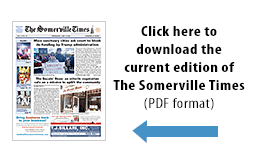
Sarah Davila and Anne Herzberg work with English Language Learners at the Welcome Center of SHS. - Photo by Andrew Firestone
Welcome Center the ‘envy’ of systems
By Andrew Firestone
Somerville is a city celebrated for its diversity, a fact that has been translated at times to ill effect among usual statistics in education ranking systems. A total of 52 percent of all students in the public schools come from families where English is not the first language spoken at home, while a total of 18 percent are classified as having limited proficiency.
Under question two, all students in public schools must learn English as quickly as possible. The fourteenth amendment also provides protection for all children and says that those of school age must be educated.
One team of educators in the Somerville public school system devoted to this task to prepare a specific group of students for tomorrow is located at the Welcome Center of Somerville High School. Here, educators make their headquarters to help over 900 students across the system with limited English proficiency, and move them forward into a brighter tomorrow.
“We created the Welcome Center sistered with the guidance department because we know that students entering the high school who are limited English proficient or are international students have specific needs,” said Sarah Davila, Administrator of Programs for English Learner Education/Familiy and Community Partnership.
“The Welcome Center is a place where we help, support, welcome, communicate with new families and students but particularly those who come to us another language other than English as their primary language,” said Superintendent Tony Pierantozzi.
“One of the things we do is we try to make it as easy as possible for the incoming families and students, so when you walk into our high school, right in the front door, our main office is on the right, on the left is the Welcome Center,” he said.
The Welcome Center offers two separate paths for students, one only using English to teach Math, Science, History and Health called the Sheltered English Immersion program, and another, for those who speak Portuguese, Spanish, Creole and French, which allows for some use of the home language to help facilitate learning, said Guidance Counselor Anne Herzberg. The students pass through four levels of English proficiency according to state guidelines.
The students there face challenges in overcoming the language barrier, said Davila, but the Somerville program supports and allows them a safe and productive environment to keep up and eventually join their comrades.
Pierantozzi was candid in discussing the issues at hand, and said that his dedicated team of educators, numbering almost 60 across the district, were not shrinking from the challenge. “The core challenge is how do students learn as well, as fast, and as deep if English isn’t their first language?”
“There’s the ESL component,” said Davila, “but then it’s not only about learning English, it’s also about the general education. It’s all the course work. It’s all the content areas. It’s math, science, social studies, etc. We’re also very committed to making sure that our students are integrated into specialists and arts and have the same advantages and access to what school life is about. So ESL is its own discipline, its own field.”
One point Davila was keen on was to make sure that the level of education was not dumbed down. “What we know about language acquisition is that it is connected to thinking processes, so we want our subjects to be rigorous and to emphasize critical thinking as well, so that students are actually thinking in another language in order to learn another language.”
“Just learning a list of words, memorizing a list of words that aren’t connected to problem solving isn’t going to be successful. But if you connect words to something that you’re doing for some reason to make it meaningful and making it more authentic, it’s going to be more effective in making the transition,” she said.
Pierantozzi made clear that the large number of students was not a single type, that the program allowed for students from all walks of life.
“When a student enters our school district we have students who are classified as English Language Learners who run the gamut from students whose parents who are both post-doctorate students at Harvard, but come with English learning needs, to students who have come from an island who are third-generation illiterate, whose families have been agrarian and who have literally never been in a school, and everything in between,” he said.
For immigrants who come into the program, the Welcome Center and the programs available allow for students to really get a supportive network of friends with similar backgrounds who may face similar insecurities.
“A lot of the students haven’t seen their parents for eight, ten years while their parents have been working here, trying to save money to bring them here. Or the opposite, they’re here and their parents are still at home, they are living with their aunts or uncles or older siblings,” said Hertzberg.
“Then we have the economic issues that are behind it,” said Peirantozzi. “A large percentage of immigrant families face economic challenges particularly in these times. We’ve lost really top students who have had to begin to earn money for their families. Many of them come from cultures where children have to begin working at a much earlier age than in the United States.”
Since last year, the Somerville schools have also offered classes for parents three times a year so that they too can come and learn to overcome the everyday struggles of living in a land where it may be difficult to overcome the language barrier. “We’re a family learning organization,” said Pierantozzi.
The East Somerville Community School also offers the two-way learning program called the “Unidos” program for students from kindergarten to eighth grade, and is only one of four in the state of its kind.
“It starts heavily in Spanish, 70/30, and then shifts over time as kids engage to 50/50, so that the ultimate result is that by eighth grade we have bilingual students in Spanish and English who have learned the content in both langauges,” said Pierantozzi.
The Welcome Center, and the other ELL programs in Somerville, have earned the admiration of education systems across the state, including the Massachusetts School Counselor’s Association, who expressed wonder deftness with which the City of Somerville is able to muster the organization and resources to so successfully combat the English immersion problem, said Herzberg.
“It’s met with, frankly, envy,” said Pierantozzi. “A lot school districts wish they had it.”















Reader Comments